A Parametric Numerical Study for Diagnosing the Failure of Large Diameter Bored Piles Using Supervised Machine Learning Approach
Abstract
:1. Introduction
2. The Reference Case Study
3. The Reference Numerical Calibration Study
4. Methodology of the Parametric Study
4.1. Adopted Parameters in the Numerical Models
4.2. Numerical Modeling and Sensitivity
4.3. Stages of Analysis
4.4. Load Transfer Mechanism and Failure Criteria
5. Analysis Results and Discussion
5.1. Large Diameter Bored Pile Load-Settlement Relationship
5.2. Pile Load Transfer Mechanism
5.3. Average Ultimate Bearing Stress
5.4. Average Ultimate Unit Skin Friction
5.5. Size of Plastic Bulb below Pile Base
6. Observations of the Ultimate Capacity of the Large Diameter Bored Piles
7. Application of the Study
8. Conclusions
- (1)
- The ultimate capacity of large diameter bored pile is increased with increases in each: pile diameter (D), pile length (L), effective soil cohesion (c’), and soil effective friction angle (Ø’). Consequently, the induced settlement at failure is also increased with the increase in any of these parameters.
- (2)
- The initial stress coefficient has a minor effect on the results up to the working loads. However, the lateral earth pressure coefficient substantially affects both the ultimate capacity and the induced settlement at the failure state. Although the ultimate capacity increases with increases in the soil lateral earth pressure coefficient (k0), the settlement of a large diameter bored pile at failure decreases with increases in the lateral earth pressure coefficient.
- (3)
- Soil Young’s modulus (E) does not affect the ultimate pile capacity. However, the settlement of a large diameter bored pile at failure is decreased with increases in this parameter.
- (4)
- The average ultimate unit skin friction is not affected by pile diameter change. In contrast, it increases with each increase in pile length, effective soil cohesion, soil lateral earth pressure coefficient, or soil effective friction angle.
- (5)
- The calculated average soil skin friction values using the Meyerhof (1976) capacity-based method are consistent with the numerical results of models with different geometrical and geotechnical parameters. However, Meyerhof’s method underestimated the soil unit skin friction, with differences ranging from 10% to 21%.
- (6)
- The ultimate bearing stress below the large diameter pile base is affected by pile diameter, pile length, soil effective cohesion, soil lateral earth pressure coefficient, and soil effective friction angle increases. However, several settlement-based methods proposed by different codes and design standards suggest constant bearing stress at a particular settlement value (i.e., 5% D) irrespective of pile geometry and without any discrimination for any class of the cohesive soils.
- (7)
- The Meyerhof (1976) capacity-based method is generally a simple analytical procedure, taking the effect of pile diameter (D), length (L), clay effective cohesion (c’), soil lateral earth pressure coefficient (k0), and soil effective friction angle (Ø’) into account, so that it can be applied in many complex situations, such as variation in the sections along a pile shaft and an inhomogeneous layered soil system. Dissimilarly, settlement-based methods ignore the effect of several influencing factors.
- (8)
- In the failure phase, the pile load transferred by friction tends to be constant or slightly decreased, and the applied load is predominantly transferred by bearing. Apparent failure is often observed through the large induced pile settlement at the end of this stage. The induced settlement at the failure state (Sf) is equal to or greater than 1.5 times the obtained settlement at 90% of the ultimate load.
- (9)
- At the failure load, the formed plastic bulb vertically extends to distances of more than 3 times the pile diameter (3D) above the pile base and 2 to 4 times (2–4D) the pile diameter below the pile base. Additionally, the diameter of the formed plastic bulb ranges from 3 to 6 times the pile diameter (3–6D) at failure state.
- (10)
- Results of the 29 numerical models applied in this parametric study can be used to develop a new theoretical method that predicts a more reliable value for the ultimate capacity of a large diameter bored pile installed in overconsolidated stiff clay soil. Moreover, the proposed decision tree can be typically utilized for several machine learning-supervised algorithms for different types and classes of soil.
Author Contributions
Funding
Institutional Review Board Statement
Informed Consent Statement
Data Availability Statement
Acknowledgments
Conflicts of Interest
References
- Meyerhof, G.G. The Ultimate Bearing Capacity of Foundations. Géotechnique. ICE Virtual Libr. 1951, 2, 301–332. [Google Scholar] [CrossRef]
- Fellenius, B.H. Unified Design of Piles and Pile Groups. Transportation Research Record 1169; Transportation Research Board: Washington, DC, USA, 1988; pp. 75–82. [Google Scholar]
- Sawant, V.A.; Shukla, S.K.; Sivakugan, N.; Das, B.M. Insight into Pile Set-Up and Load Carrying Capacity of Driven Piles. Int. J. Geotech. Eng. 2013, 7, 71–83. [Google Scholar] [CrossRef]
- Wael, N. Evaluation of the Ultimate Capacity of Friction Piles. Sci. Res. Eng. J. 2012, 4, 778–789. [Google Scholar] [CrossRef] [Green Version]
- Tawfik, M.M. Assessment of Load Settlement Behavior of Large Diameter Bored Piles in Sand under Axial Compression Loads. Ph.D. Thesis, Faculty of Engineering, Ain Shams University, El-Khalyfa, Egypt, 2010; pp. 320–333. [Google Scholar]
- El Gendy, M.; El-Arabi, I.A.; Kamal, M.A. Comparative analyses of large diameter bored piles using international codes. J. Deep. Found. Inst. 2014, 8, 15–26. [Google Scholar] [CrossRef]
- Reese, L.C.; Isenhower, W.M.; Wang, S.T. Analysis and Design of Shallow and Deep Foundations; John Wiley: Hoboken, NJ, USA, 2006. [Google Scholar]
- Omer, J.; Rokni, S. 3D Finite Element Assessment of the Effects of Energy Loops on the Load Capacity and Settlement of Bored Piles Installed in Sand. Int. J. Geotech. Eng. 2018, 12, 472–483. [Google Scholar] [CrossRef] [Green Version]
- Shahin, M.A. Intelligent Computing for Modelling Axial Capacity of Pile Foundations. Can. Geotech. J. 2010, 47, 230–243. [Google Scholar] [CrossRef] [Green Version]
- Rollins, K.M.; Clayton, R.J.; Mikesell, R.C.; Blaise, B.C. Drilled Shaft Side Friction in Gravelly Soils. J. Geotech. Geoenviron. Eng. ASCE 2005, 131, 987–1003. [Google Scholar] [CrossRef]
- Poulos, H.G.; Davis, E.H. The Settlement Behavior of Single Axially Loaded Incompressible Piles and Piers. Géotechnique ICE Virtual Libr. 1968, 18, 351–371. [Google Scholar] [CrossRef]
- Yang, J. Influence Zone for End Bearing of Piles in Sand. Journal of Geotechnical and Geoenvironmental Engineering ASCE Libr. 2006, 132, 1229–1237. [Google Scholar] [CrossRef]
- Shahin, M.A. Artificial Intelligence in Geotechnical Engineering: Applications, Modeling Aspects, and Future Directions. In Metaheuristics in Water, Geotechnical and Transport Engineering; Elsevier: Amsterdam, The Netherlands, 2013; pp. 169–204. [Google Scholar] [CrossRef]
- Abu-Kiefa, M.A. General regression neural networks for driven piles in cohesionless soils. J. Geotech. Geoenviron. Eng. ASCE Libr. 1998, 124, 1177–1185. [Google Scholar] [CrossRef]
- Pal, M.; Deswal, S. Modelling pile capacity using Gaussian process regression. Comput. Geotech. 2010, 37, 942–947. [Google Scholar] [CrossRef]
- Park, S.; Roberts, L.; Misra, A. Static load test interpretation using the t-z model and LRFD resistance factors for auger cast-in-place (AC IP) and drilled displacement (DD) piles. Int. J. Geotech. Eng. 2011, 5, 283–295. [Google Scholar] [CrossRef]
- Boonyatee, T.; Lai, Q.V. A non-linear load transfer method for determining the settlement of piles under vertical loading. Int. J. Geotech. Eng. 2020, 14, 206–2017. [Google Scholar] [CrossRef]
- DIN 4014. German Association for Earthworks and Foundation Engineering; Deutsches Institute fur Normung: Berlin, Germany, 1990. [Google Scholar]
- ECP 202/4. Egyptian Code for Soil Mechanics–Design and Construction of Foundations. Part 4, Deep Foundations; The Housing and Building Research Center (HBRC): Cairo, Egypt, 2005. [Google Scholar]
- Fellenius, B.H. What Capacity to Choose from the Results of a Static Loading Test; Deep Foundation Institute: Hawthorne, NJ, USA, 2001; pp. 19–22. [Google Scholar]
- Meyerhof, G.G. Theory and Practice of Pile Foundations. In Proceedings of the first International Conference–Piling and Deep Foundations, Beijing, China; 1986; pp. 177–186. [Google Scholar]
- Reese, L.C.; O‘Neill, M.W. Field Load Tests of Drilled Shafts. In Proceedings of the International Seminar on Deep Foundations on Bored and Auger Piles, Rotterdam, The Netherlands, 7–10 June 1988; pp. 145–192. [Google Scholar]
- Eid, M.; Hefny, A.; Sorour, T.; Zaghloul, Y.; Ezzat, M. Numerical Analysis of Large Diameter Bored Pile Installed in Multi Layered Soil: A Case Study of Damietta Port New Grain Silos Project. Int. J. Curr. Eng. Technol. INPRESSCO 2018, 8, 218–226. [Google Scholar] [CrossRef] [Green Version]
- Mullins, G.; Dapp, S.D.; Lai, P. Pressure Grouting Drilled Shaft Tips in Sand. In Proceedings of the New technological and design developments in deep foundations, Geo-Denver, CO, USA, 5–8 August 2000; pp. 1–17. [Google Scholar] [CrossRef] [Green Version]
- Hansen, J.B. Discussion on hyperbolic stress-strain response in cohesive soils. J. Soil Mech. Found. Div. ASCE Libr. 1963, 89, 241–242. [Google Scholar] [CrossRef]
- Chin, F.K. Estimation of the ultimate load of piles from tests not carried to failure. In Proceedings of the 2nd. South-East Asian Conference on Soil Engineering, Singapore, 11–15 June 1970; pp. 81–90. [Google Scholar]
- Eid, M.; Hefny, A.; Sorour, T.; Zaghloul, Y.; Ezzat, M. Full-Scale Well Instrumented Large Diameter Bored Pile Load Test in Multi-Layered Soil: A Case Study of Damietta Port New Grain Silos Project. Int. J. Curr. Eng. Technol. Inpressco Int. Press 2018, 8, 85–98. [Google Scholar] [CrossRef] [Green Version]
- American Association of State Highway and Transportation Officials. Bridge Design Specification, SI Units, Interim Revisions, 3rd ed.; American Association of State Highway and Transportation Officials: Washington, DC, USA, 2005. [Google Scholar]
- Alkroosh, I.S.; Bahadori, M.; Nikraz, H.; Bahadori, A. Regressive approach for predicting bearing capacity of bored piles from cone penetration test data. J. Rock Mech. Geotech. Eng. 2015, 7, 584–592. [Google Scholar] [CrossRef] [Green Version]
- Nejad, F.P.; Jaksa, M.B. Load-settlement behavior modeling of single piles using artificial neural networks and CPT data. Comput. Geotech. 2017, 89, 9–21. [Google Scholar] [CrossRef]
- Zhou, W.; Wang, L.; Guo, Z.; Liu, J.; Rui, S. A novel tz model to predict the pile responses under axial cyclic loadings. Comput. Geotech. 2019, 112, 120–134. [Google Scholar] [CrossRef]
- Moshfeghi, S.; Eslami, A. Study on pile ultimate capacity criteria and CPT-based direct methods. Int. J. Geotech. Eng. 2018, 12, 28–39. [Google Scholar] [CrossRef]
- Mohanty, R.; Suman, S.; Das, S.K. Prediction of vertical pile capacity of driven pile in cohesionless soil using artificial intelligence techniques. Int. J. Geotech. Eng. 2018, 12, 209–216. [Google Scholar] [CrossRef]
- Delua, J. Supervised vs. Unsupervised Learning: What’s the Difference? 2021. Available online: https://www.ibm.com/cloud/blog/supervised-vs-unsupervised-learning (accessed on 4 August 2021).
- He, X.; Xu, H.; Sabetamal, H.; Sheng, D. Machine learning aided stochastic reliability analysis of spatially variable slopes. Comput. Geotech. 2020, 126, 103711. [Google Scholar] [CrossRef]
- Samui, P. Support vector machine applied to settlement of shallow foundations on cohesionless soils. Comput. Geotech. 2008, 35, 419–427. [Google Scholar] [CrossRef]
- Makasis, N.; Narsilio, G.A.; Bidarmaghz, A. A machine learning approach to energy pile design. Comput. Geotech. 2018, 97, 189–203. [Google Scholar] [CrossRef]
- Sommer, H.; Hammbach, P. Großpfahlversuche im Ton für die Gründung der Talbrücke Alzey. Der Bauingenieur 1974, 49, 310–317. [Google Scholar]
- Al-Atroush, M.E.; Hefny, A.; Zaghloul, Y.; Sorour, T. Behavior of a Large Diameter Bored Pile in Drained and Undrained Conditions: Comparative Analysis. Geosciences 2020, 10, 261. [Google Scholar] [CrossRef]
- Wehnert, M.; Vermeer, P.A. Numerical Analyses of Load Tests on Bored Piles, Numerical Models in Geomechanics; NUMOG 9th: Ottawa, ON, Canada, 2004. [Google Scholar]
- Ezzat, M.; Zaghloul, Y.; Sorour, T.; Hefny, A.; Eid, M. Numerical Simulation of Axially Loaded to Failure Large Diameter Bored Pile. Int. J. Earth Energy Environ. Sci. 2019, 13, 1–15. [Google Scholar] [CrossRef]
- Meyerhof, G.G. Bearing Capacity and Settlement of Pile Foundations. J. Geotech. Eng. Div. ASCE Libr. 1976, 102, 197–228. [Google Scholar] [CrossRef]
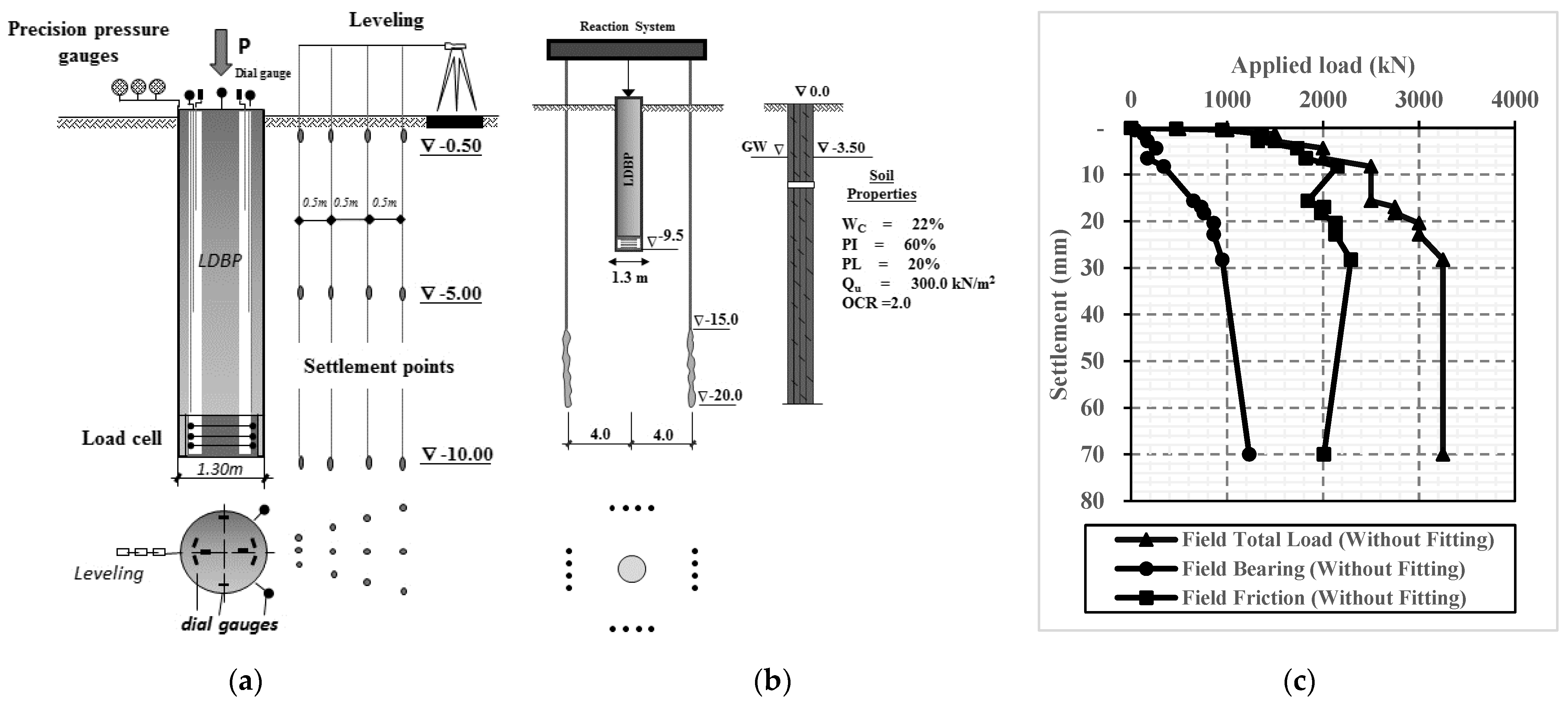
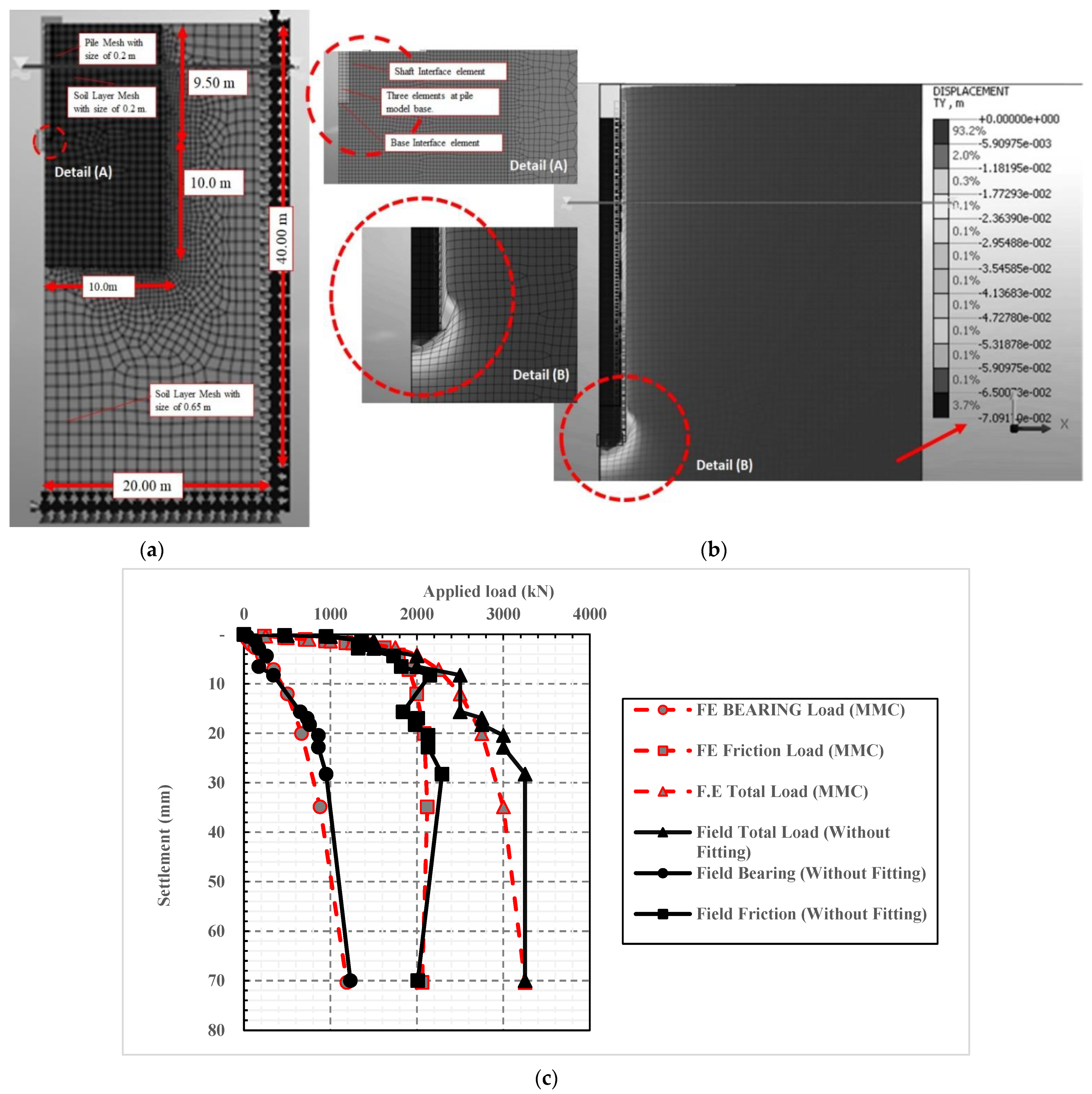
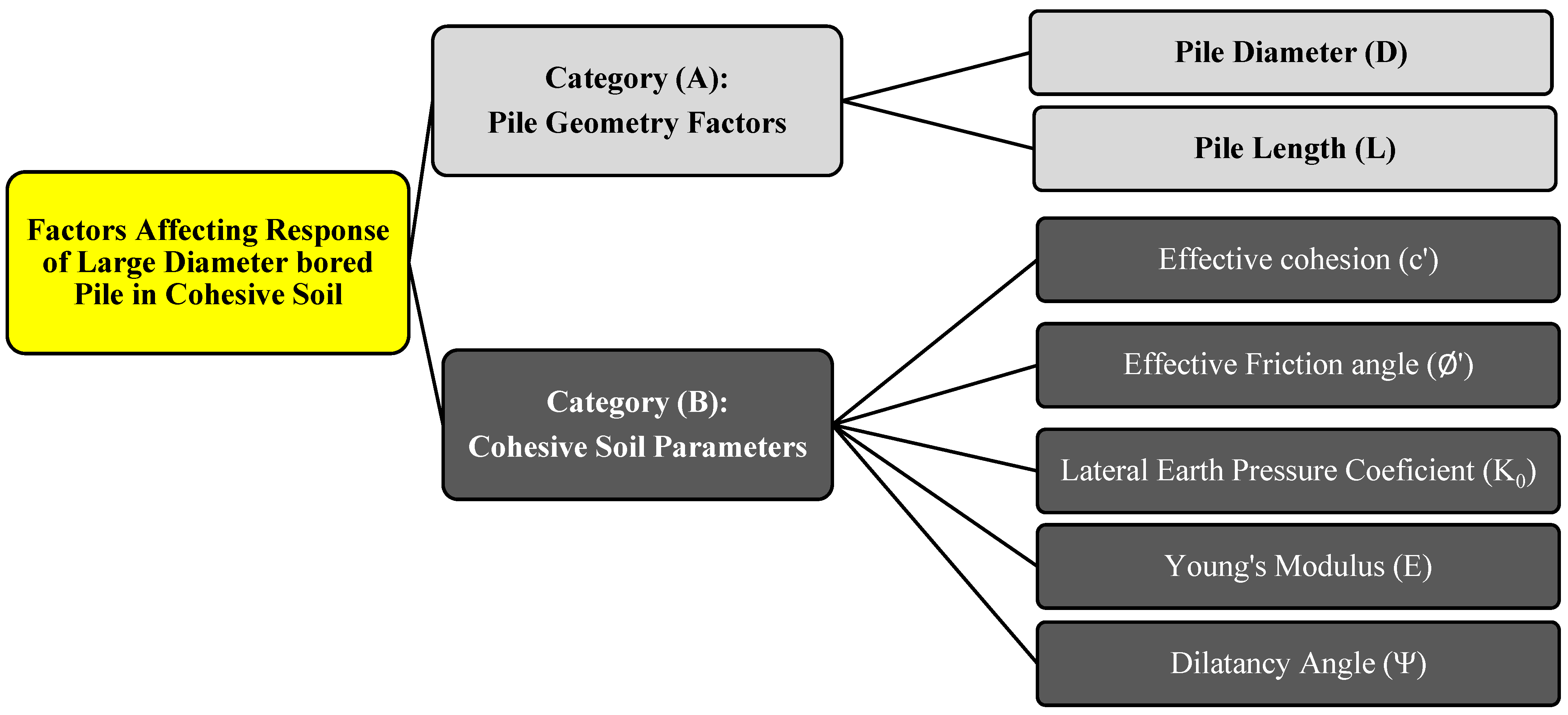
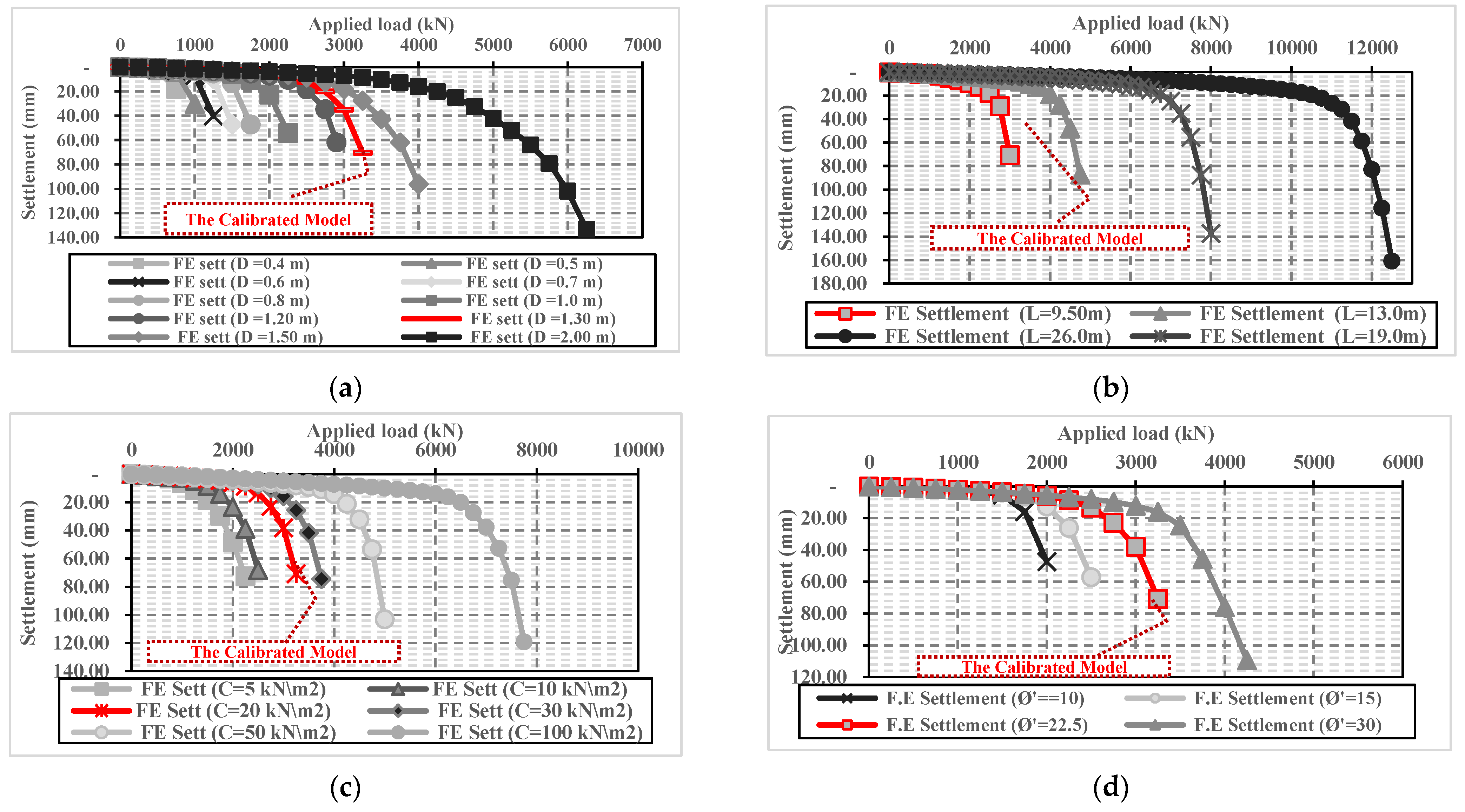
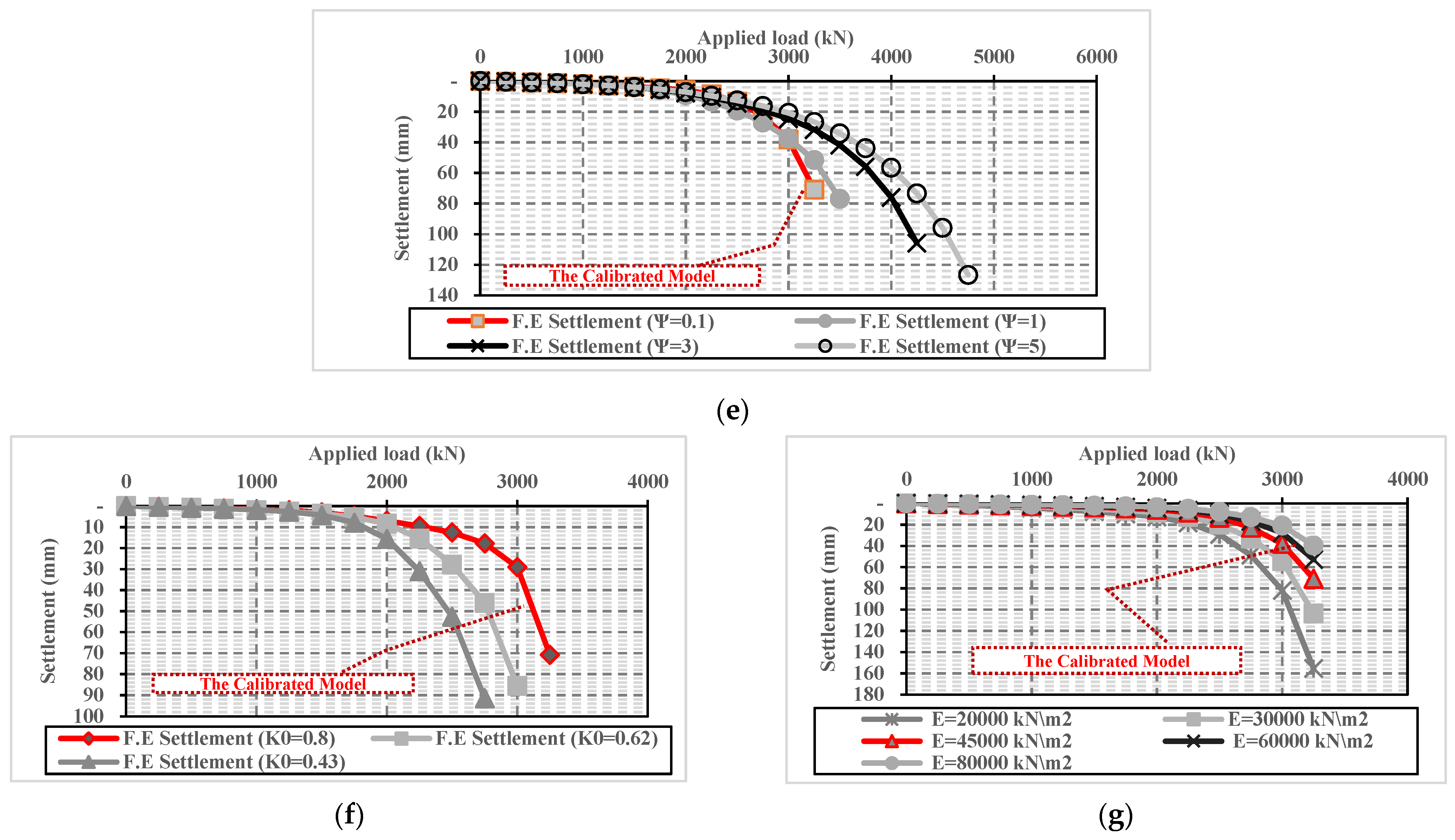

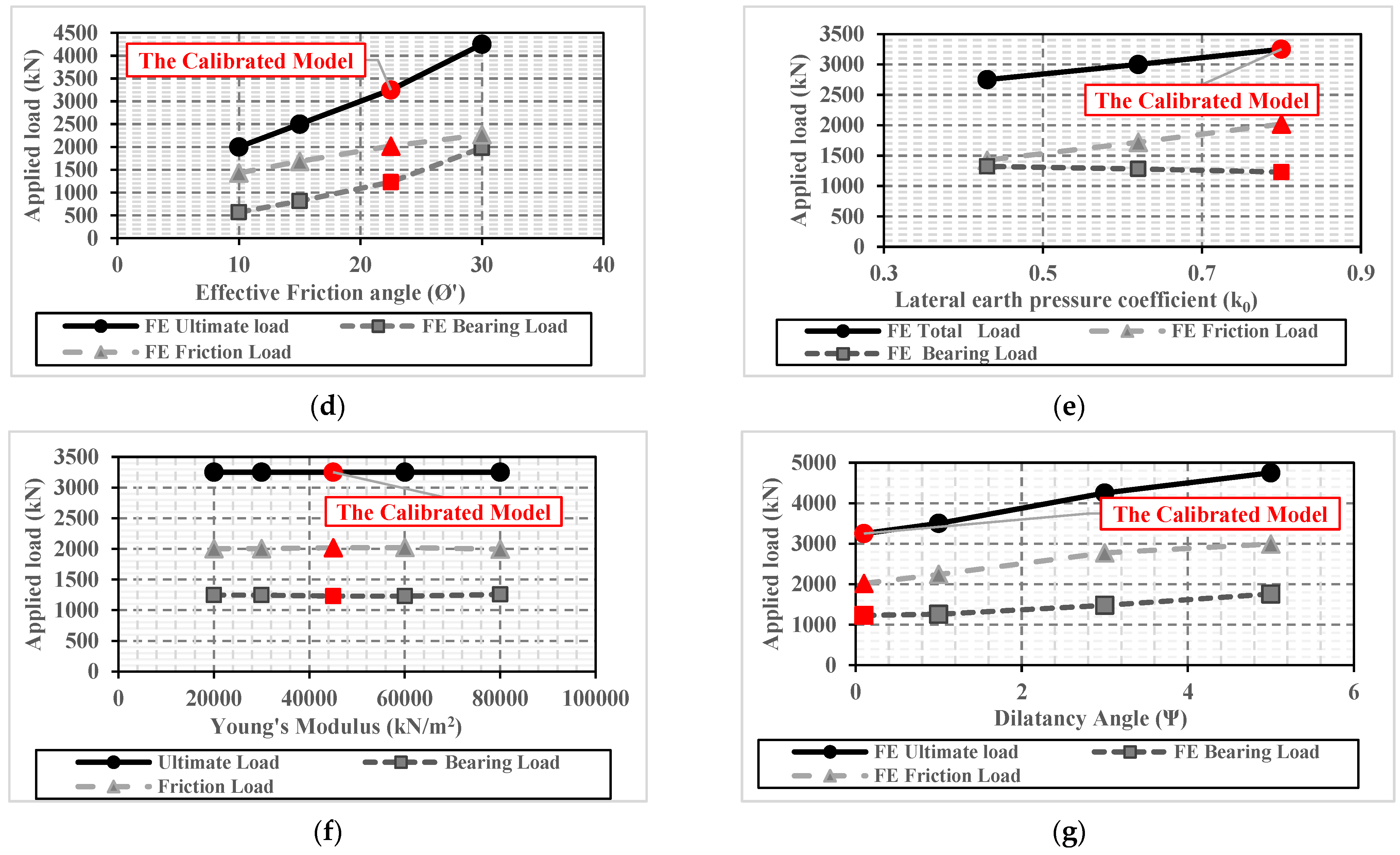
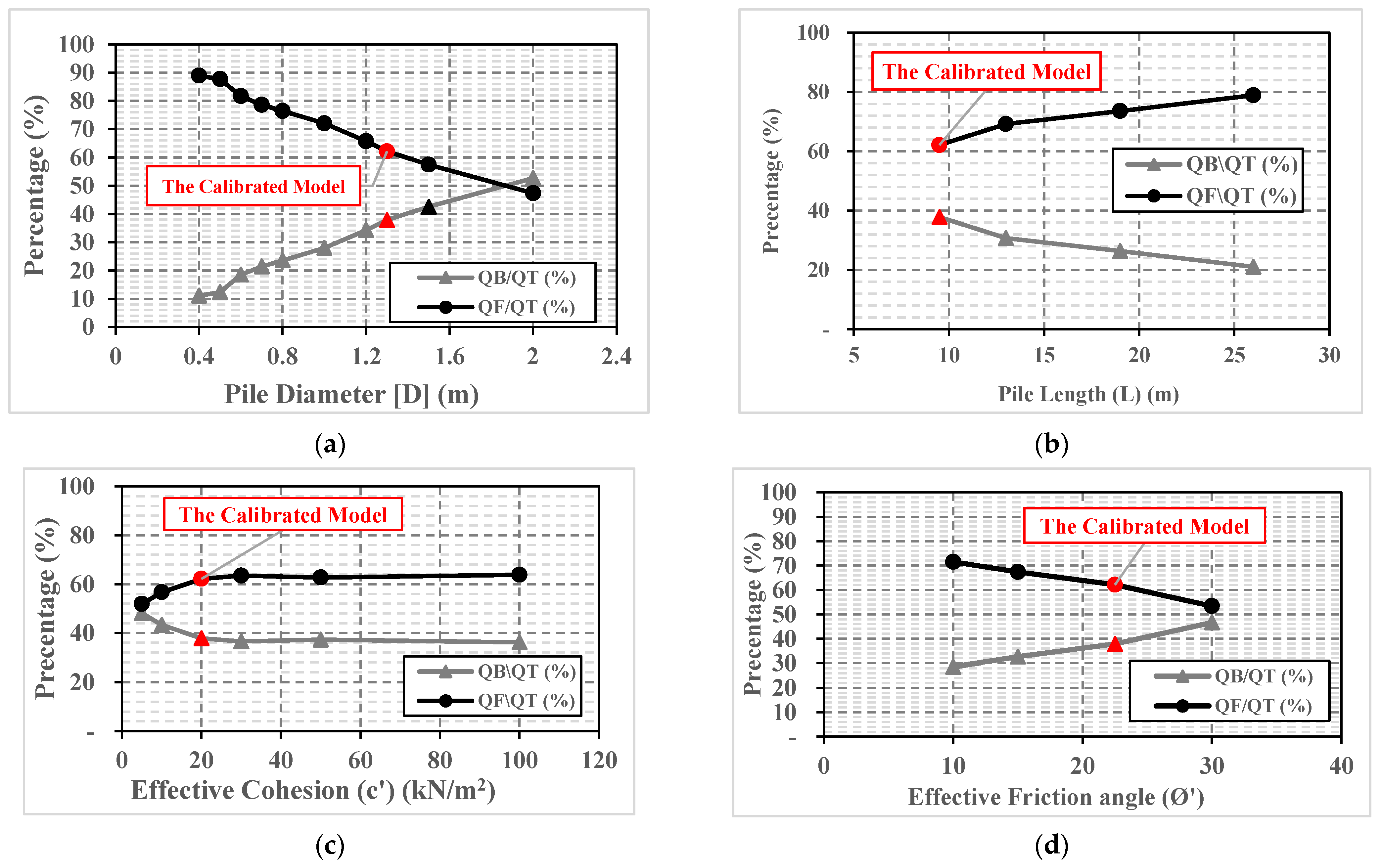


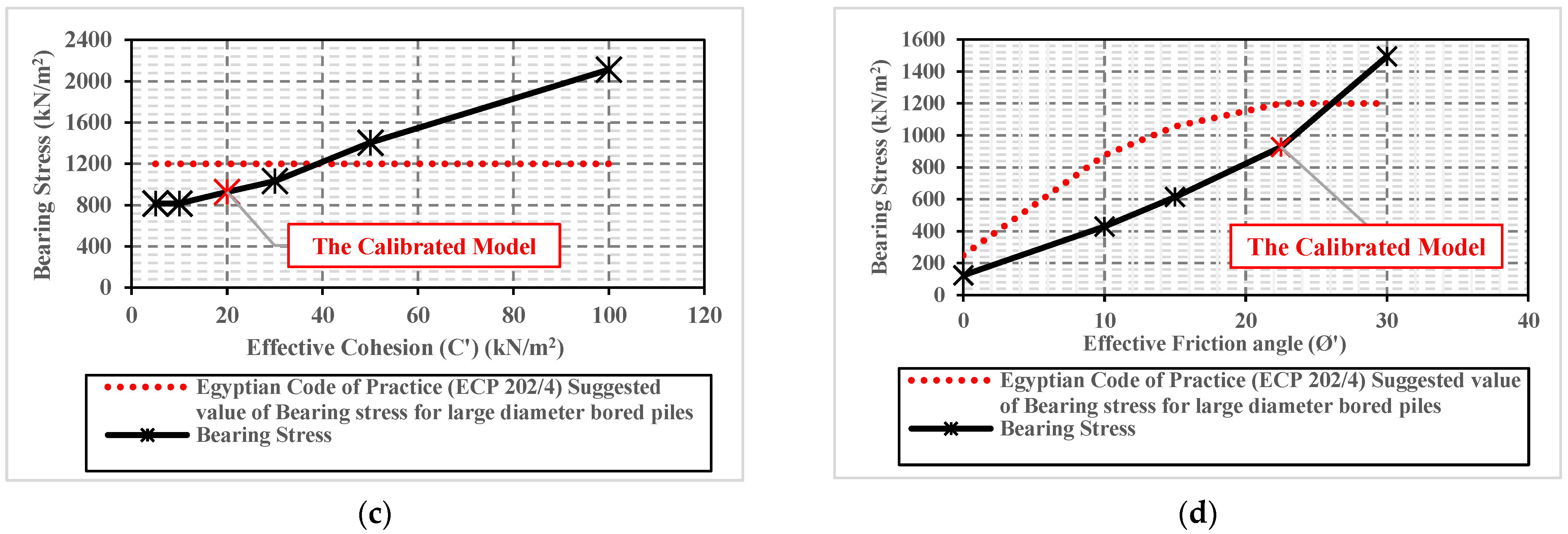


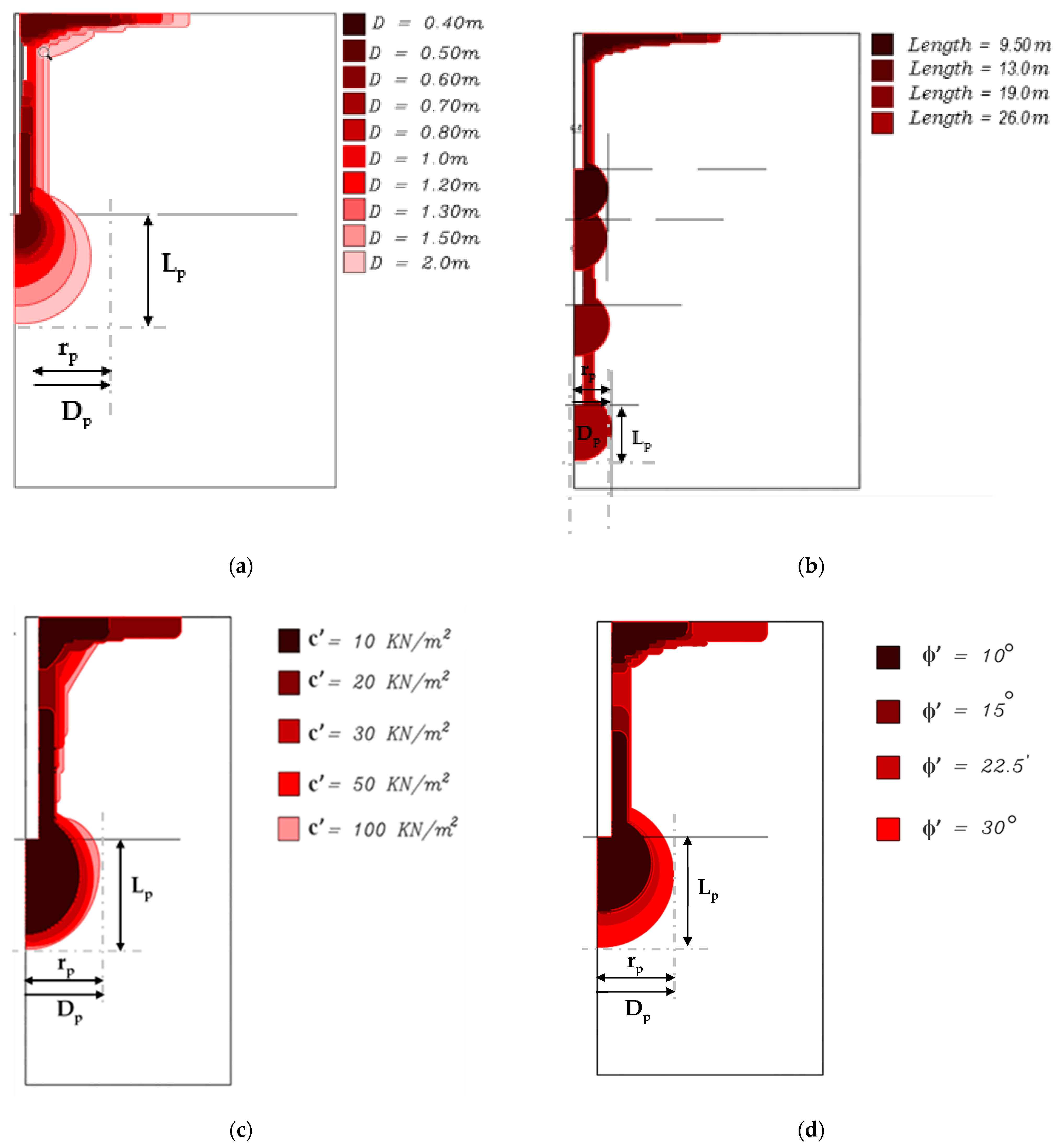
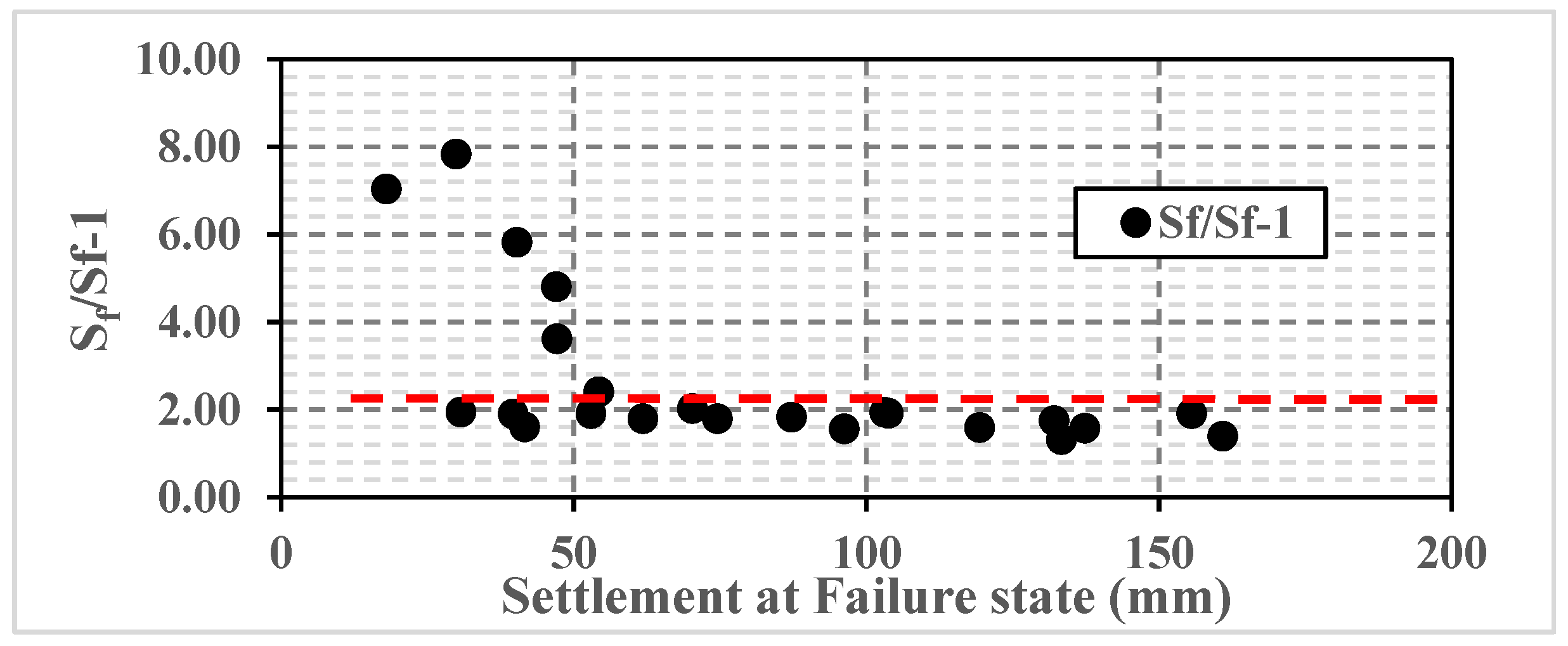
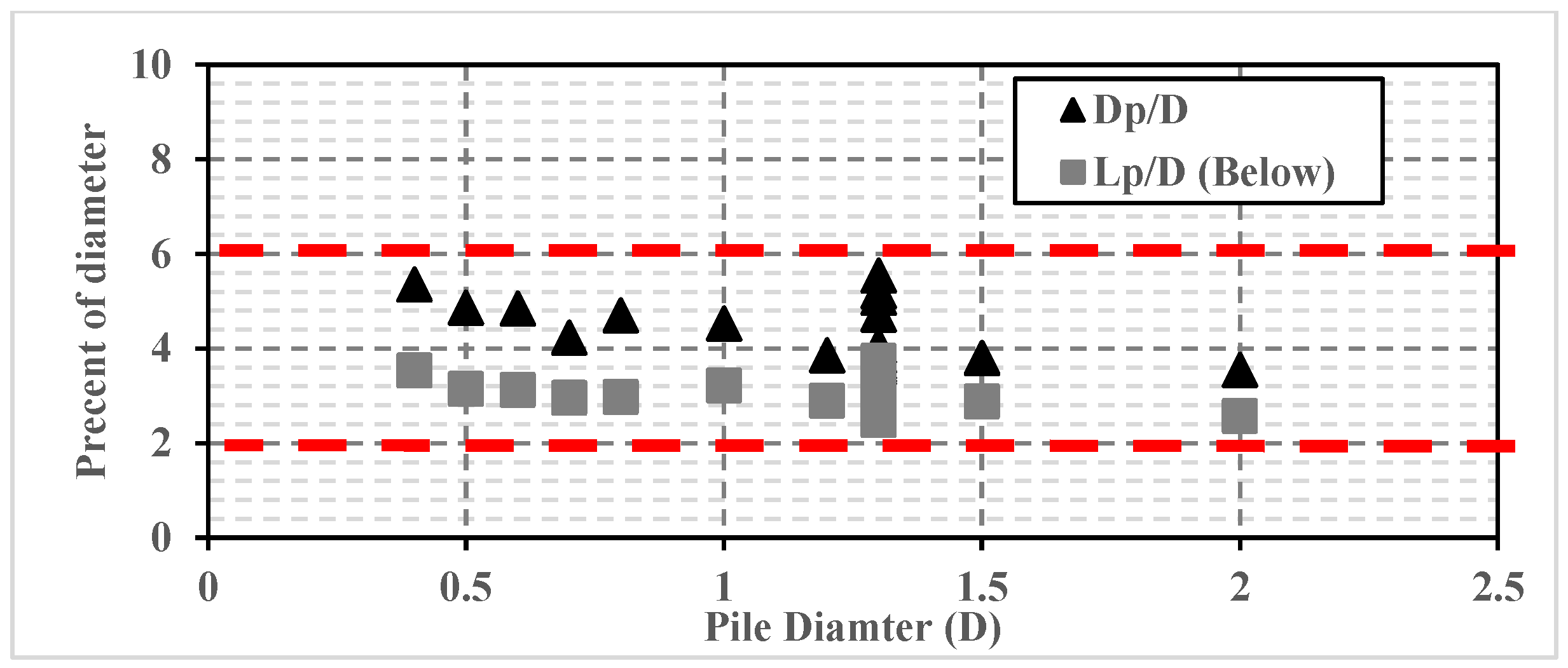
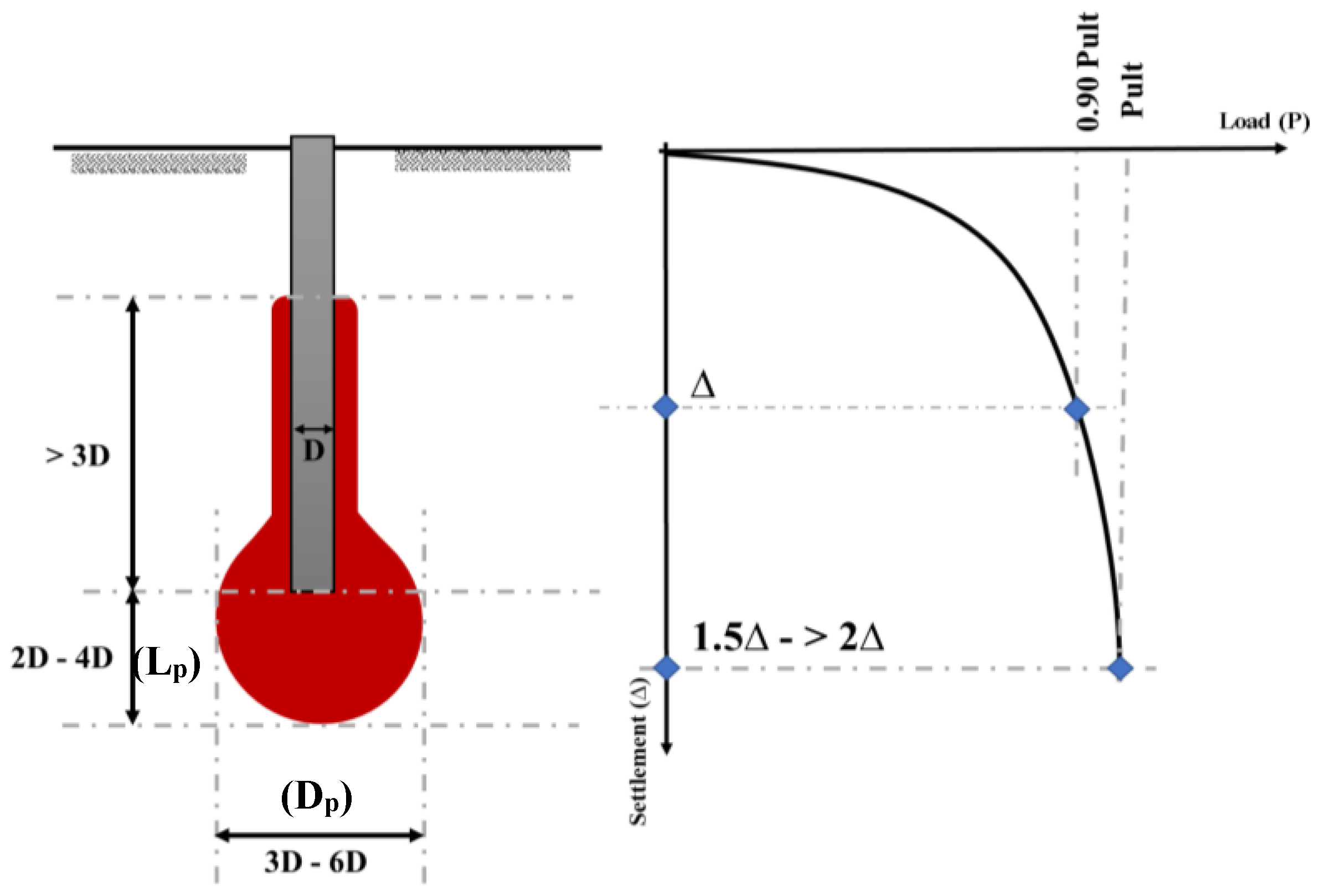
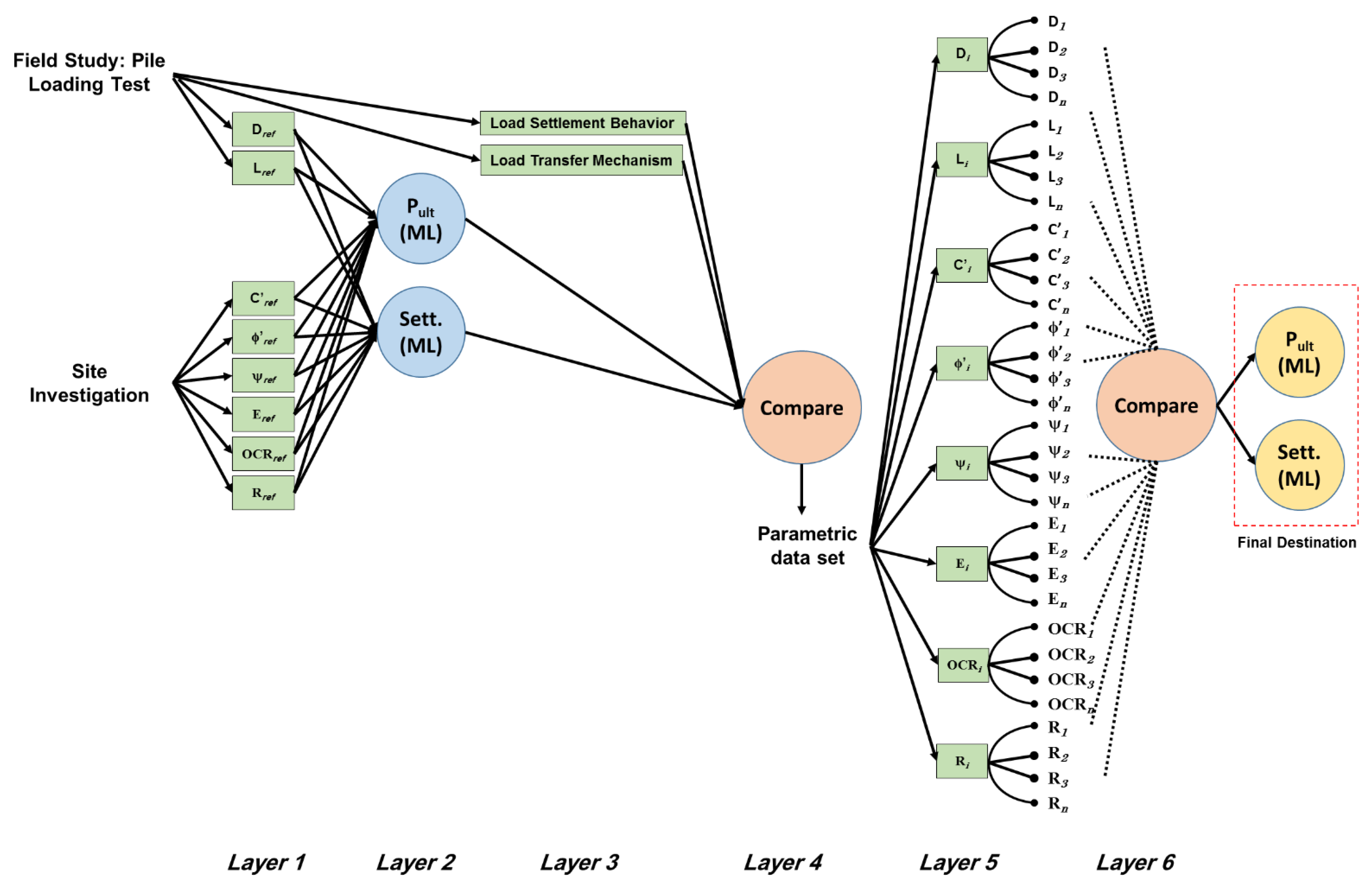
| Pile Structural Parameters | Overconsolidated Stiff Clay Soil Parameters | |||||||||||||
|---|---|---|---|---|---|---|---|---|---|---|---|---|---|---|
| Model No | D | L | Eelastic | µ | ɣc | γunsat\ γsat | ν | C | Ø | K0 | ψ | R | ||
| Units | m | m | kN/m2 | - | kN/m3 | kN/m3 | - | kN/m2 | o | kN/m2 | kN/m2 | - | o | - |
| 1 (The Calibrated Model) | 1.3 | 9.5 | 24,248,711 | 0.2 | 24 | 20 | 0.3 | 20 | 22.5 | 45,000 | 90,000 | 0.8 | 0.1 | 1 |
| 2 | 0.4 | 9.5 | 24,248,711 | 0.2 | 24 | 20 | 0.3 | 20 | 22.5 | 45,000 | 90,000 | 0.8 | 0.1 | 1 |
| 3 | 0.5 | 9.5 | 24,248,711 | 0.2 | 24 | 20 | 0.3 | 20 | 22.5 | 45,000 | 90,000 | 0.8 | 0.1 | 1 |
| 4 | 0.6 | 9.5 | 24,248,711 | 0.2 | 24 | 20 | 0.3 | 20 | 22.5 | 45,000 | 90,000 | 0.8 | 0.1 | 1 |
| 5 | 0.7 | 9.5 | 24,248,711 | 0.2 | 24 | 20 | 0.3 | 20 | 22.5 | 45,000 | 90,000 | 0.8 | 0.1 | 1 |
| 6 | 0.8 | 9.5 | 24,248,711 | 0.2 | 24 | 20 | 0.3 | 20 | 22.5 | 45,000 | 90,000 | 0.8 | 0.1 | 1 |
| 7 | 1 | 9.5 | 24,248,711 | 0.2 | 24 | 20 | 0.3 | 20 | 22.5 | 45,000 | 90,000 | 0.8 | 0.1 | 1 |
| 8 | 1.2 | 9.5 | 24,248,711 | 0.2 | 24 | 20 | 0.3 | 20 | 22.5 | 45,000 | 90,000 | 0.8 | 0.1 | 1 |
| 9 | 1.5 | 9.5 | 24,248,711 | 0.2 | 24 | 20 | 0.3 | 20 | 22.5 | 45,000 | 90,000 | 0.8 | 0.1 | 1 |
| 10 | 2.0 | 9.5 | 24,248,711 | 0.2 | 24 | 20 | 0.3 | 20 | 22.5 | 45,000 | 90,000 | 0.8 | 0.1 | 1 |
| 11 | 1.3 | 13 | 24,248,711 | 0.2 | 24 | 20 | 0.3 | 20 | 22.5 | 45,000 | 90,000 | 0.8 | 0.1 | 1 |
| 12 | 1.3 | 19 | 24,248,711 | 0.2 | 24 | 20 | 0.3 | 20 | 22.5 | 45,000 | 90,000 | 0.8 | 0.1 | 1 |
| 13 | 1.3 | 26 | 24,248,711 | 0.2 | 24 | 20 | 0.3 | 20 | 22.5 | 45,000 | 90,000 | 0.8 | 0.1 | 1 |
| 14 | 1.3 | 9.5 | 24,248,711 | 0.2 | 24 | 20 | 0.3 | 20 | 22.5 | 20,000 | 40,000 | 0.8 | 0.1 | 1 |
| 15 | 1.3 | 9.5 | 24,248,711 | 0.2 | 24 | 20 | 0.3 | 20 | 22.5 | 30,000 | 60,000 | 0.8 | 0.1 | 1 |
| 16 | 1.3 | 9.5 | 24,248,711 | 0.2 | 24 | 20 | 0.3 | 20 | 22.5 | 60,000 | 120,000 | 0.8 | 0.1 | 1 |
| 17 | 1.3 | 9.5 | 24,248,711 | 0.2 | 24 | 20 | 0.3 | 20 | 22.5 | 80,000 | 160,000 | 0.8 | 0.1 | 1 |
| 18 | 1.3 | 9.5 | 24,248,711 | 0.2 | 24 | 20 | 0.3 | 20 | 10 | 45,000 | 90,000 | 0.8 | 0.1 | 1 |
| 19 | 1.3 | 9.5 | 24,248,711 | 0.2 | 24 | 20 | 0.3 | 20 | 15 | 45,000 | 90,000 | 0.8 | 0.1 | 1 |
| 20 | 1.3 | 9.5 | 24,248,711 | 0.2 | 24 | 20 | 0.3 | 20 | 30 | 45,000 | 90,000 | 0.8 | 0.1 | 1 |
| 21 | 1.3 | 9.5 | 24,248,711 | 0.2 | 24 | 20 | 0.3 | 5 | 22.5 | 45,000 | 90,000 | 0.8 | 0.1 | 1 |
| 22 | 1.3 | 9.5 | 24,248,711 | 0.2 | 24 | 20 | 0.3 | 10 | 22.5 | 45,000 | 90,000 | 0.8 | 0.1 | 1 |
| 23 | 1.3 | 9.5 | 24,248,711 | 0.2 | 24 | 20 | 0.3 | 30 | 22.5 | 45,000 | 90,000 | 0.8 | 0.1 | 1 |
| 24 | 1.3 | 9.5 | 24,248,711 | 0.2 | 24 | 20 | 0.3 | 50 | 22.5 | 45000 | 90,000 | 0.8 | 0.1 | 1 |
| 25 | 1.3 | 9.5 | 24,248,711 | 0.2 | 24 | 20 | 0.3 | 100 | 22.5 | 45,000 | 90,000 | 0.8 | 0.1 | 1 |
| 26 | 1.3 | 9.5 | 24,248,711 | 0.2 | 24 | 20 | 0.3 | 20 | 22.5 | 45,000 | 90,000 | 0.43 | 0.1 | 1 |
| 27 | 1.3 | 9.5 | 24,248,711 | 0.2 | 24 | 20 | 0.3 | 20 | 22.5 | 45,000 | 90,000 | 0.62 | 0.1 | 1 |
| 28 | 1.3 | 9.5 | 24,248,711 | 0.2 | 24 | 20 | 0.3 | 20 | 22.5 | 45,000 | 90,000 | 0.8 | 1.0 | 1 |
| 29 | 1.3 | 9.5 | 24,248,711 | 0.2 | 24 | 20 | 0.3 | 20 | 22.5 | 45,000 | 90,000 | 0.8 | 3.0 | 1 |
| 30 | 1.3 | 9.5 | 24,248,711 | 0.2 | 24 | 20 | 0.3 | 20 | 22.5 | 45,000 | 90,000 | 0.8 | 5.0 | 1 |
Publisher’s Note: MDPI stays neutral with regard to jurisdictional claims in published maps and institutional affiliations. |
© 2021 by the authors. Licensee MDPI, Basel, Switzerland. This article is an open access article distributed under the terms and conditions of the Creative Commons Attribution (CC BY) license (https://creativecommons.org/licenses/by/4.0/).
Share and Cite
Al-Atroush, M.E.; Hefny, A.M.; Sorour, T.M. A Parametric Numerical Study for Diagnosing the Failure of Large Diameter Bored Piles Using Supervised Machine Learning Approach. Processes 2021, 9, 1411. https://doi.org/10.3390/pr9081411
Al-Atroush ME, Hefny AM, Sorour TM. A Parametric Numerical Study for Diagnosing the Failure of Large Diameter Bored Piles Using Supervised Machine Learning Approach. Processes. 2021; 9(8):1411. https://doi.org/10.3390/pr9081411
Chicago/Turabian StyleAl-Atroush, Mohamed E., Ashraf M. Hefny, and Tamer M. Sorour. 2021. "A Parametric Numerical Study for Diagnosing the Failure of Large Diameter Bored Piles Using Supervised Machine Learning Approach" Processes 9, no. 8: 1411. https://doi.org/10.3390/pr9081411
APA StyleAl-Atroush, M. E., Hefny, A. M., & Sorour, T. M. (2021). A Parametric Numerical Study for Diagnosing the Failure of Large Diameter Bored Piles Using Supervised Machine Learning Approach. Processes, 9(8), 1411. https://doi.org/10.3390/pr9081411






